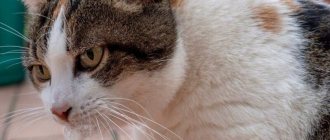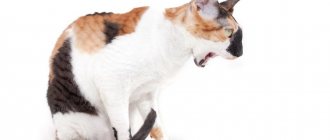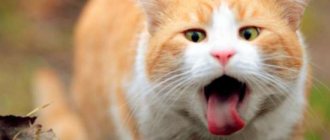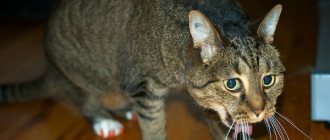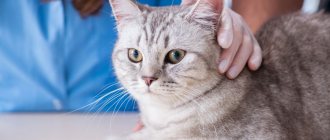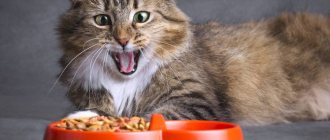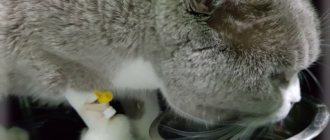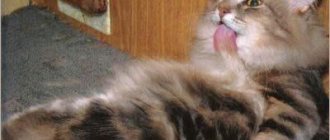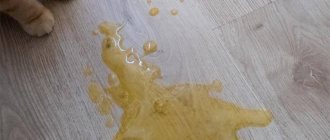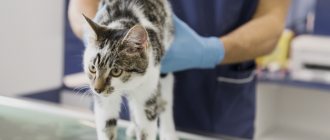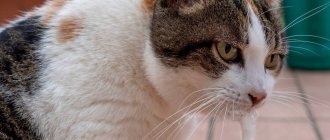Pet owners often experience that their domestic cat vomits undigested food after eating. This happened once, the cat feels normal, then vomiting is the body’s reaction to indigestion. If your pet is vomiting, the reason is not only banal overeating, but also serious disorders of the digestive tract. Such a deviation cannot be ignored. Observe the animal and you may need the help of a doctor.
Causes of vomiting that are not harmful to health
If vomiting happened once, we are talking about physiological functions of the body that are not dangerous for the pet. Occurs from overeating or rapid absorption of food. There are families with several pets. They compete with each other and try to swallow as much food as possible. The digestive system is not ready for such a volume and the cat regurgitates excess after eating.
Poor quality feed contains 3% meat and a small amount of protein. When consuming cheap feed, the amount of enzymes for digesting food is reduced, and food is not digested. This way the cat vomits after eating and cleanses the gastrointestinal tract. In addition to meat and protein, cheap food contains by-products and flavoring additives, which also cause vomiting.
If after vomiting the pet is cheerful and cheerful, there is no need to panic; the cause was overeating.
Therapeutic measures
A veterinarian's help is needed if vomiting continues for more than a day; the cat vomits several times a day after each feeding or even without food. If in the vomit, in addition to food, impurities of blood or bile are found, there is no appetite and the animal refuses to drink water, the help of a specialist is needed immediately.
After the examination, the veterinarian will suggest additional examination, if necessary, make a diagnosis and prescribe treatment.
Drug therapy
Treatment for vomiting is selected depending on the reasons that caused this condition. In case of poisoning, enterosorbents are used to prevent the absorption of toxins into the bloodstream, and a gentle diet with plenty of fluids is prescribed.
If the animal is infected with parasites, antihelminthic drugs are used. They are given based on body weight twice with an interval of 7-14 days (details are indicated in the instructions for each specific drug).
For diseases of the gastrointestinal tract, antibacterial, enzyme, and anti-inflammatory drugs are used, and droppers are prescribed. Treatment is carried out under the supervision of a veterinarian. Self-administration of medications can harm the cat, worsen its condition and lead to death.
If vomiting is a secondary symptom of a viral infection, then the root cause is eliminated. For this purpose, the cat is prescribed a number of drugs: antiviral and antibacterial, immunomodulatory, nutritional, probiotic and others.
It is necessary to follow all the veterinarian's instructions and complete the course according to his recommendations, and not when the animal feels better. An untreated illness can return with a vengeance.
Diet
If there is repeated vomiting, you need to remove food: the cat should be on a starvation diet until the nausea and diarrhea stop. Then, for two days, you should give the cat light food in small portions 5-7 times a day.
Suitable products would be:
- puree from boiled rabbit or poultry meat;
- rice water or boiled rice;
- vegetable puree from boiled carrots, pumpkin, broccoli in a light meat broth;
- actually, the meat broth itself.
If everything is fine after two days, the cat can be gradually transferred to a regular diet.
What not to do if your cat vomits after eating
Vomiting in a cat after eating can occur at any time - you need to be prepared for anything. Even if it’s just regurgitation of fur, you should never do the following:
- force an animal to eat and drink;
- independently prescribe medications;
- self-medicate the animal;
- attempt a gastric lavage or enema without consulting a veterinarian;
- scold the animal for damaging the carpet or furniture.
Performing such actions will negatively affect the health of the animal. Newly introduced food or water into the body will cause new attacks of nausea, and the use of medications should only be carried out in accordance with the doctor’s treatment regimen. The only thing that can be done if a cat vomits after eating is to observe him, examine the vomit and provide rest. The latter will not be superfluous if you suspect any disease.
Serious violations
- A common cause of indigestion is food poisoning of poor quality. The cat vomits all the time before and after eating, diarrhea appears, this speeds up the process of removing toxins from the body.
- Viruses and bacteria lead to the death of a pet. Therefore, a visit to the veterinarian is urgent.
- Food contaminated with chemicals or poisonous plants can cause indigestion. They are prepared for rats and mice, dangerous for pets.
If vomiting returns repeatedly, blood and mucus are noticed in the vomit, the cat vomits before and after eating, and becomes lethargic, what to do in this case. The answer is clear - you need to see a veterinarian and after finding out the reasons, drug treatment will be indicated.
Types of vomiting in cats
First, let's talk about physiological vomiting, which is not dangerous to your pet's health. It could be:
- Vomiting from eating grass - cats use it to cleanse the body. If a cat ate green grass and vomited green grass, then this is normal and even healthy. However, sometimes cats quite successfully digest all the grass, and if they eat it, this does not mean that vomiting will soon begin.
Cats love green grass, with which they cleanse their bodies and replenish their supply of vitamins.
- Vomiting from psychological trauma - Some cats may react by vomiting to moving, rearranging furniture, or introducing a new pet into the house. Knowing this characteristic of a cat, it is better not to feed the animal on this day or reduce the amount of food - this will help prevent an unpleasant reaction from the cat’s body.
- Vomiting from motion sickness during long trips is quite common in cats. To prevent such vomiting, you can use mild herbal-based sedatives, and do not feed your pet for 7-8 hours before the trip.
- Vomiting from eating inedible objects - some cats tend to swallow threads, pieces of plastic, candy wrappers, hair ties and even small toys. As a rule, in such animals vomiting occurs easily and frees the body from inedible objects. However, if difficulties or symptoms of difficulty breathing occur in a cat with such vomiting, you should immediately consult a doctor.
- Vomiting from swallowing fur - sometimes cats get nervous and lick their fur especially actively, after which they may even develop bald spots on their stomachs. To facilitate the removal of fur from the body, there are special vitamins and treats, and you can also help the cat by introducing a teaspoon of petroleum jelly into the mouth.
Similar products can be used for cats of any kind, especially long-haired breeds, which often tear their hair.
Non-dangerous vomit is most often transparent, with visible and understandable contents: wool, grass, threads, pieces of food.
Vomiting after eating undigested food or dry food
This is a typical type of vomiting seen in domestic cats. The rapid pace of food absorption, large volumes and poor chewing lead to the fact that the stomach does not have time to stretch and throws the contents back. The cat may vomit immediately near the bowl or a few minutes or even half an hour after eating. The animal can then return to the bowl and ask for food again. There is only one way out - limit food portions. Dry food must be chewed so that you can hear how its pieces crunch. If the animal swallows them whole, then the likelihood of vomiting increases greatly. In addition, when washed down with water, the food actively swells in the stomach, so initially the cat needs to eat much less.
Eating greedily and quickly is the most common cause of vomiting in cats.
The author of the article has a beloved old cat of the Thai breed, which is already 17 years old. In the last 3-4 years she has been vomiting quite often, and we are very familiar with this problem. About 1-2 times a week she regurgitates dry food, which she previously swallowed without chewing. She has special, premium food, designed for good digestion, the pieces are not very hard, they are easy to chew. But the cat already has very bad teeth, so from time to time, when she is too lazy or has no time to grind the pieces, she eats them quietly, quickly and without any crunching. This process is also influenced by the presence of a second animal in our house, a young and healthy cat, who eats completely different food from his bowl nearby (for young castrated males), but looks towards the cat in order to move it away from the feeder and eat everything that lies there. Usually we follow this process and do not allow the cat to eat someone else’s food, but sometimes we get distracted and see the final scene: the cat walking away from its bowl and the cat finishing the food behind it. Therefore, the cat periodically eats greedily, quickly, without chewing, after which after 10–15 minutes, maximum half an hour, it begins to slurp and lick its lips, then runs to the floor, coughs there, and it is on the carpet (favorite place) that the entire contents of breakfast or dinner are thrown out. It looks like slightly overcooked (rarely) or not chewed food at all (usually). The cat feels guilty and immediately hides. Sometimes she doesn’t have time to reach the floor and vomits right on the bed where she sleeps. I have to clean up piles of food after her and wash her beds. It's not scary, but it's unpleasant. This happens about once a week. If you feed your cat wet food of the same line, there will be no vomiting, because it is soft and well crushed. Usually after a bout of vomiting I feed her a little less than usual. But we must give the cat his due; after burping, she never returns to the bowl and asks for more food. She arranges a diet for herself for 3-4 hours, and only then intensively asks to eat. Sometimes after an attack of vomiting he goes to a bowl of water and drinks a lot. The funny thing is that the cat, when he was young, tried to eat the food that she regurgitated. Now he has wised up and doesn’t do that anymore. Sometimes a cat also vomits hair, but this happens very rarely, about once every 2-3 months, during periods of active shedding. A young cat also vomits, but very rarely and never with food. He has two problems - vomiting grass when he eats too much, and vomiting foam with fur during active shedding. But since a cat licks itself much less than a cat, it also vomits its fur literally a couple of times a year and little by little. And the pet regurgitates the grass in the warm season, when we walk with him on a harness, and he absorbs the grass in the quantities his body needs. It can be concluded that young cats have far fewer problems with vomiting than older cats. And it is better to switch old cats to wet food, this will serve as a preventive measure against vomiting.
Vomiting yellow liquid (bile)
Vomiting bile means that the animal has not eaten for more than 24 hours or the contents of the stomach have previously been completely released into the environment. Bile is released from the small intestine, liver, and duodenum. This is usually a sign that the cat is hungry and not feeling well, often accompanied by lethargy and lack of appetite. In this case, it is better to show the animal to a veterinarian.
If, in addition to vomiting, the animal has a lack of appetite and a lethargic state, then you need to take it to the veterinarian for examination as quickly as possible.
If the bile is dark yellow in color, it may be hepatic vomiting associated with a foreign body inside the body or parasites.
Persistent, repeated vomiting of bile in a pet may indicate chronic diseases of the gallbladder, liver or intestines. Fatty or stale food, overeating and swallowing large pieces of food can provoke an exacerbation.
Vomiting white foam
The appearance of white foam means hungry vomiting, which is formed due to the secretion of juice in an empty stomach. To protect the mucous membrane from an aggressive environment, a special protein is produced in the stomach, which comes out in the form of white foam.
This occurs due to long-term fasting, the presence of parasites, gastritis, chemical poisoning, etc. Vomiting with white foam, occurring 1-2 times while maintaining appetite, is not considered dangerous, but if there was more urge to vomit, it is reduced or There is no appetite, and the animal’s condition is causing concern, then a doctor’s consultation is required.
Kitten vomiting
Vomiting in kittens is very dangerous and the younger the baby is, the less chance of saving him even with qualified medical care. Dehydration has a detrimental effect on kittens and can quickly lead to death. Most often, vomiting at an early age indicates congenital disorders of the digestive system or low-quality mother's milk. Difficulties in treating cubs are associated with the unpredictable effects of drugs on the young body.
Kittens from 3 months of age are considered as adult animals and the same treatment methods are applied to them.
Other types of vomiting
Vomiting blood is considered the most dangerous and always requires medical intervention. Most often, it indicates a viral infection or an exacerbation of a peptic ulcer. Also, persistent, prolonged vomiting can cause small vessels in the digestive tract to burst. Brown blood is undigested blood, which means liver dysfunction or other dangerous diseases, so the owner of the animal will need to take urgent measures in order not to lose the pet - it must be taken to a veterinary clinic as quickly as possible.
Green vomit means problems with the pancreas, blockage of the gastrointestinal tract, which is often observed with infectious and viral diseases.
Video: Vomiting in cats - veterinarian advice
Character of vomiting after eating
Vomiting is not a violation, but is a sign of cleansing the body of a physiological nature. Before taking action, look at the consistency and appearance of the vomit. If suspicious lumps are found in the contents, then you should immediately contact a veterinary clinic.
- Undigested food. Overfed or swallowed too quickly in large pieces. An isolated case is not a reason to visit a doctor. Constant, after eating - the functioning of the pancreas is disrupted.
- Pieces of wool. In long-haired breeds, vomiting can be caused by tyrchobezoars - hairballs. The pet licks itself and swallows fur, which accumulates in the stomach and causes discomfort. Large pieces irritate the stomach wall and make it difficult to digest food normally.
- Bile and foaming. The cat vomits food containing bile immediately after eating. Dysfunction of the gallbladder or liver is suspected. In some cases, white foam is present in the vomit.
Reduce stress and anxiety
Due to stress and anxiety, your cat may become sick after eating. Stress can be caused by changes in your cat's diet or home environment. Have you added a new pet or person to your home? Or maybe someone is no longer there, or you have moved to a new house?
Perhaps your neighbor's kitten is being walked outside, and your cat may be experiencing stress for territorial reasons. Look for other signs of stress, such as hair loss, hiding in seclusion or unfamiliar places, or meowing loudly.
© shutterstock
Diagnosis and treatment of the disease
A doctor's help will be needed if your pet is vomiting for more than one day or if it happens every day.
At the veterinary clinic, the cat will be diagnosed and monitored for health. The doctor will palpate the abdominal cavity. Palpation will reveal dense nodes and congestion. In addition, it is important for the doctor to find out in detail what the cat has been doing recently and its diet. If necessary, additional laboratory tests will be ordered. In rare cases, surgery will be required after diagnosis.
The doctor selects treatment based on the reasons. In case of poisoning, enterosorbents and a diet with plenty of fluids are prescribed. In case of parasitic infection, antihelminthic drugs are given. For problems with the gastrointestinal tract, antibiotics, anti-inflammatory drugs and enzymes are prescribed.
A cat regurgitates food: normal or pathological
Regurgitation of food is normal, but vomiting is pathological. Regurgitation occurs once or twice a day and not every day. The vomited material consists of food fragments or a white foamy mass. In this case, the pet is monitored and managed without the help of a veterinarian.
If attacks of vomiting occur 3 or more times a day or are repeated daily, this is a pathology that requires specialist intervention.
What can cause vomiting
From a physiological point of view, vomiting is caused by irritation of receptors located in the esophagus and stomach. In cats, there are dangerous and non-dangerous causes of vomiting.
Dangerous reasons
Dangerous causes include diseases that lead to the rapid death of an animal. These include:
- poisoning with toxic substances (household chemicals, poisonous plants, some medications);
- blockage of the gastrointestinal tract by foreign substances;
- exacerbation of internal diseases such as ulcerative gastritis, chronic renal failure, liver lipidosis, etc.
- neoplasms in the stomach and intestines;
- viral diseases such as panleukopenia, feline infectious peritonitis, leukemia.
Associated symptoms for dangerous causes of vomiting include complete refusal to eat, loose stools, or constipation. The pet may become lethargic, sad, and its coat may become dull.
Non-dangerous causes of vomiting
The concept of “non-dangerous reasons” is, of course, conditional. Typically, these include chronic diseases of the pet that do not require emergency treatment at the clinic.
- Gastritis and sensitive digestion - most often these diseases develop as a result of improper feeding of the pet;
- Vomiting caused by wool getting into the stomach; however, it must be taken into account that even a hairball can lead to complete obstruction of the gastrointestinal tract and the need for surgical intervention;
- Vomiting due to stress or motion sickness, for example, when traveling in a car;
- Vomiting as a result of helminthic infestation;
- Vomiting during pregnancy of a pet, etc.
There are usually no associated symptoms in this case. But the cat may, for example, become more lethargic, eat less and refuse to play.
Cat vomiting with other symptoms
Often when cats vomit, they also have other symptoms. Describing all of your cat's symptoms to your veterinarian will be important in determining the correct diagnosis or treatment.
Your cat is vomiting and won't eat.
Cats often don't want to eat if they feel sick. You may see this in a variety of conditions including foreign bodies, kidney and liver disease, severe diabetes, inflammatory bowel disease, etc.
Your cat is vomiting and constipated
If your cat hasn't had a bowel movement in a couple of days and is trying to walk, he's probably constipated. This can cause contents to accumulate in the small intestine and stomach, causing nausea and vomiting in the cat.
Your cat is vomiting and has diarrhea.
This combination of symptoms tells us that there is inflammation not only in the stomach, but also in the small and/or large intestine.
Your cat is vomiting and sneezing
If your cat is vomiting and sneezing, he may have contracted a virus (such as coronavirus). Cats that become ill (vomiting) often develop an upper respiratory tract infection.
This is because most cats become infected with certain viruses, such as herpesvirus, as kittens and may behave normally until they become immune.
Your cat is vomiting and drinking a lot
Cats may vomit after drinking large amounts of water. They may also have a medical condition that causes them to drink a lot and vomit, such as kidney disease, diabetes, and cancer.
Your cat is vomiting and pooping on the floor.
Cats may defecate on the floor if they are constipated or have an increased urge to go to the toilet, which is associated with intestinal inflammation and diarrhea.
